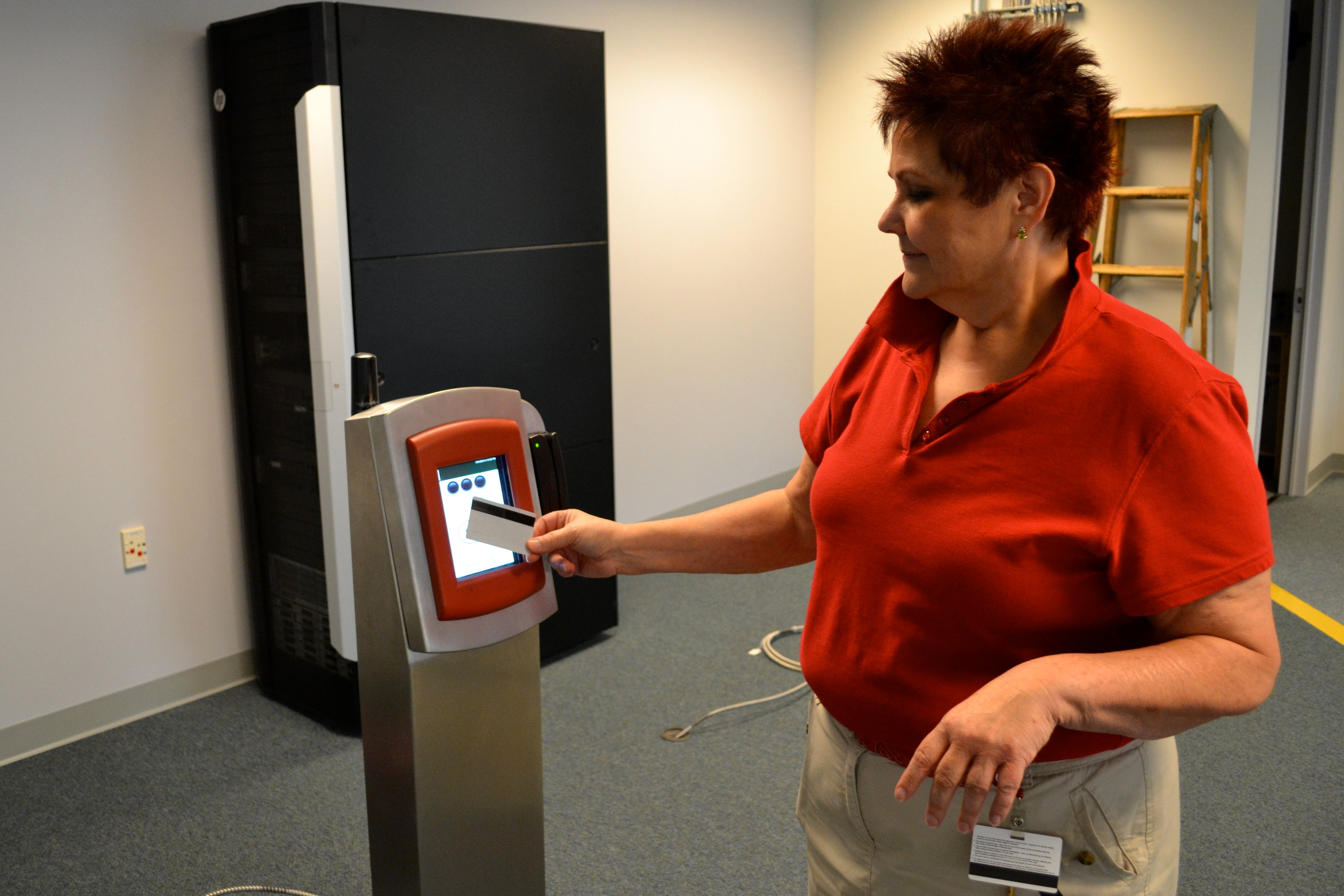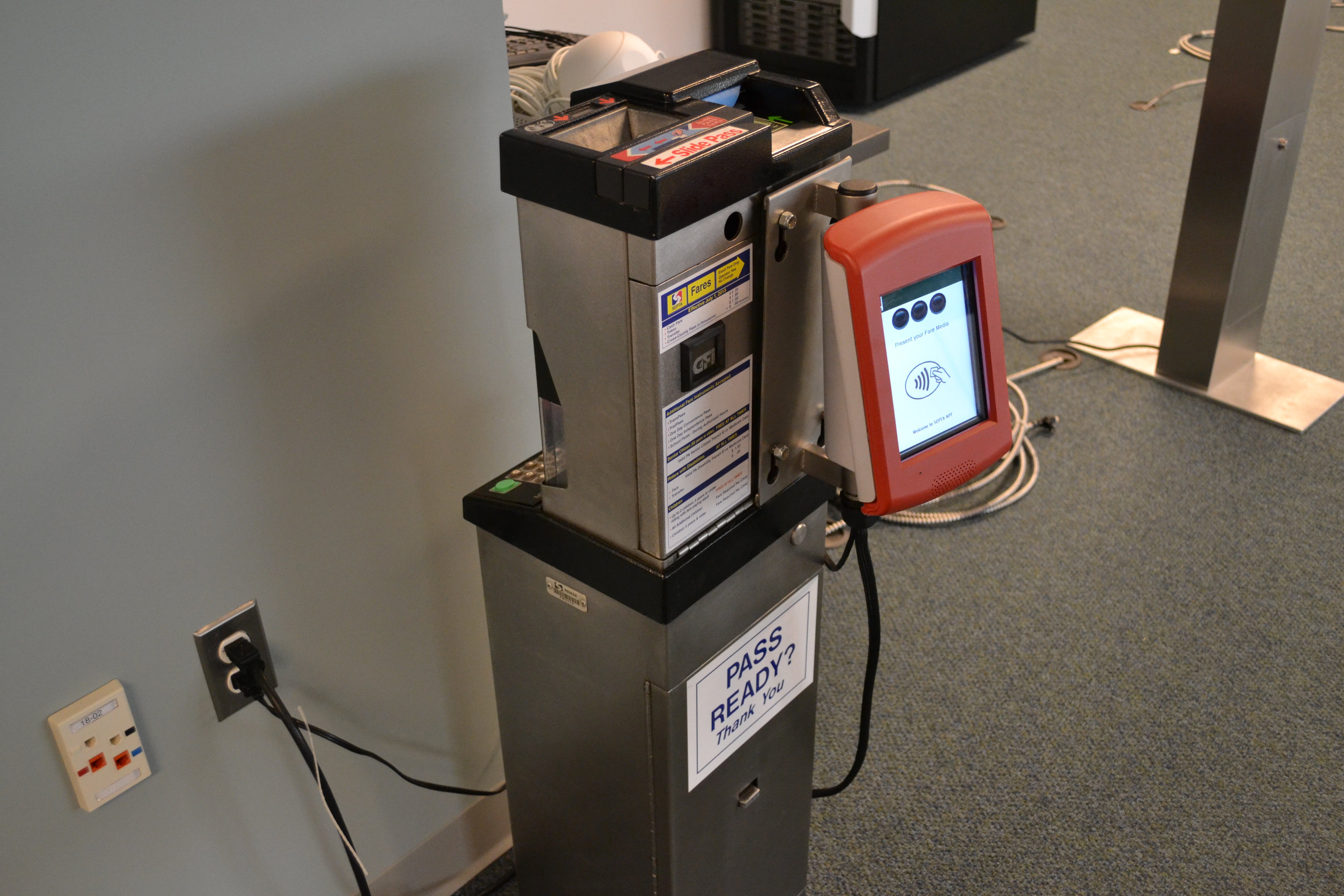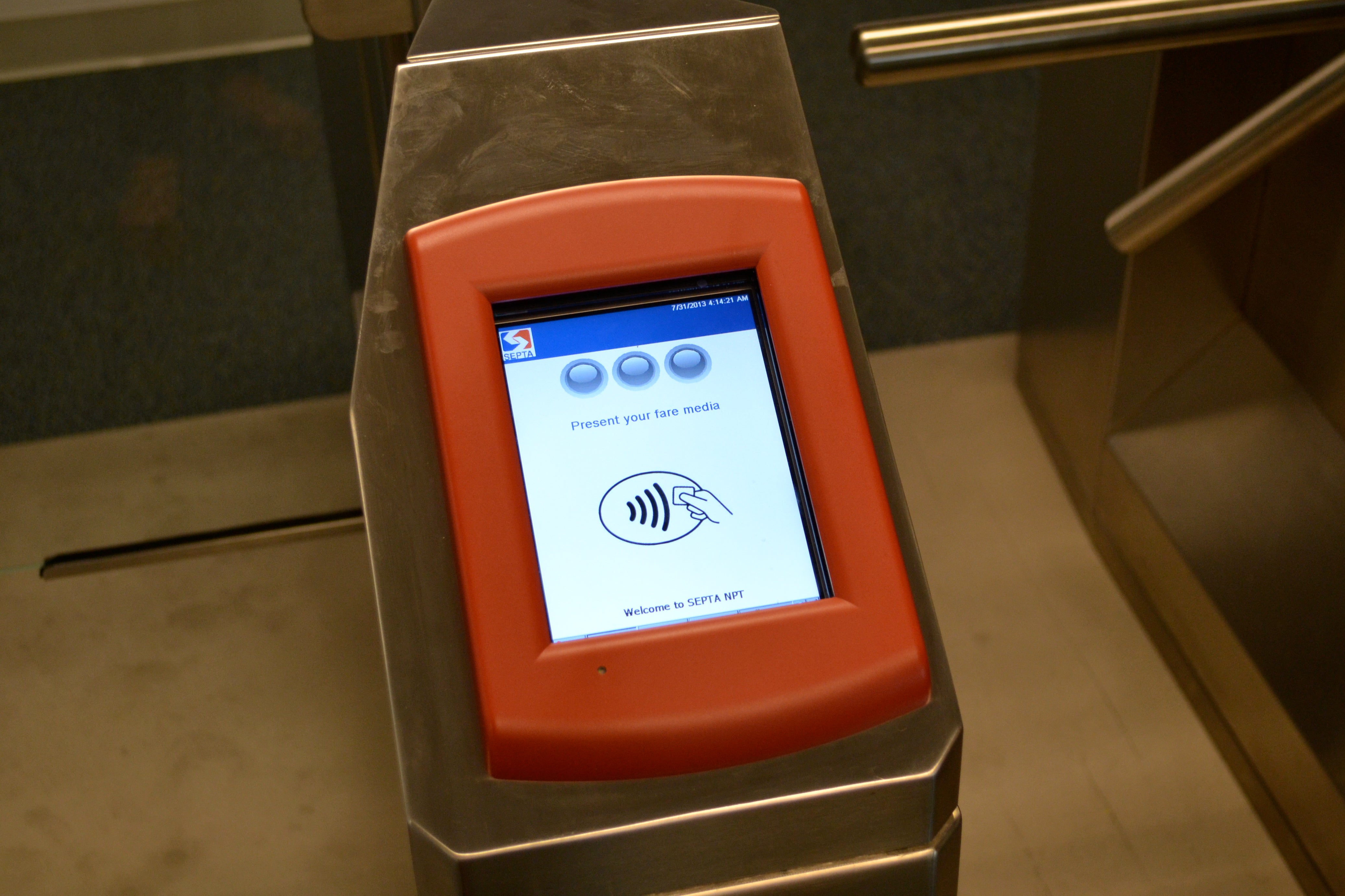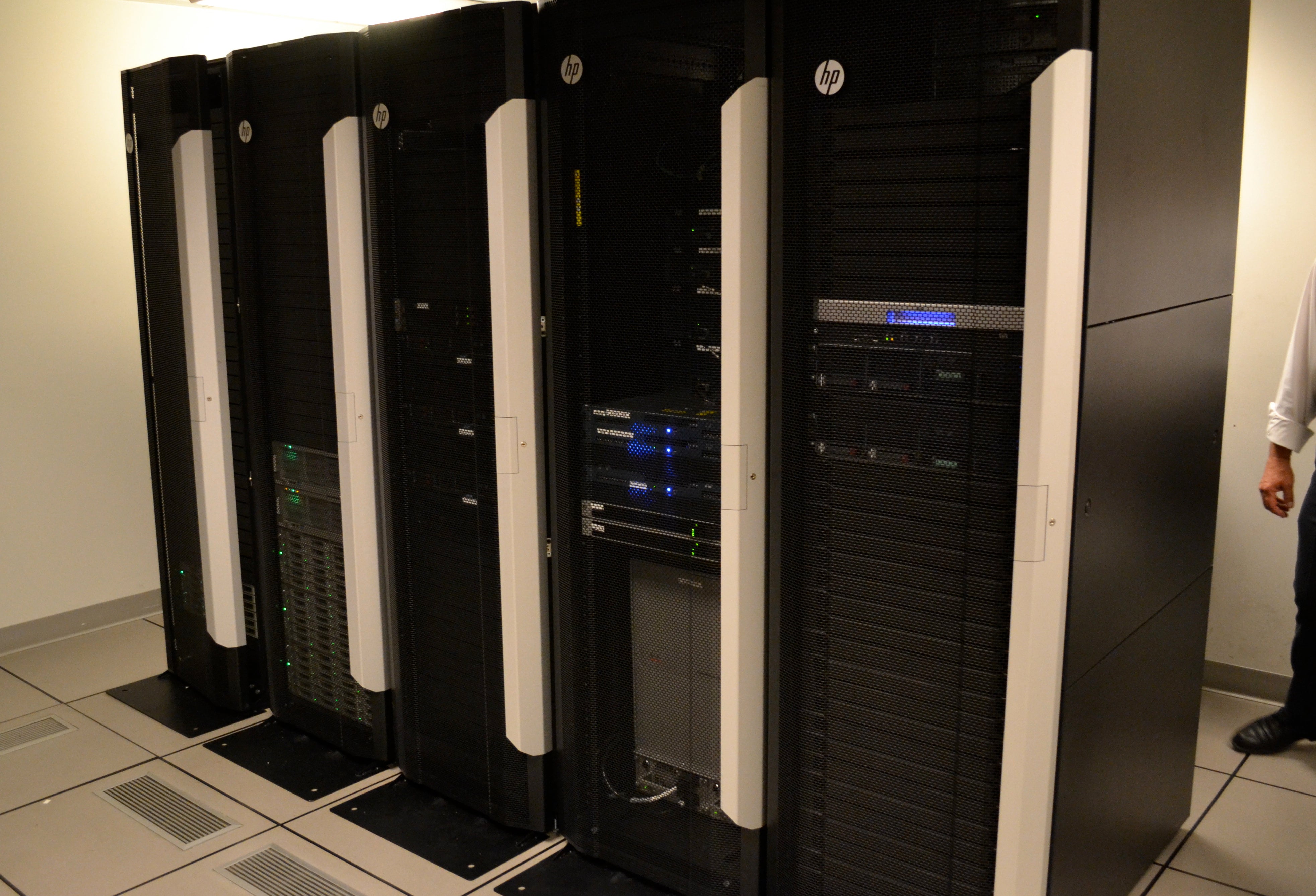SEPTA’s New Payment Technology takes shape at Center City test facility

In October, SEPTA’s new payment technology (NPT) test facility was an empty former storage room with a plywood “turnstile” in one corner. Nine months later the NPT timeline has fallen behind slightly, but progress is visible in that space, where SEPTA has installed several sleek, functioning prototypes.
NPT is the technology that will replace SEPTA’s outdated, token-based fare payment system with a new, “smart” system that will allow users to pay with “new media,” including SEPTA-issued cards and NFC-chip equipped devices like phones and bank cards.
When it comes to NPT, SEPTA staff sometimes speak in metaphors.
About advancing NPT, SEPTA’s Chief Officer of NPT John McGee said, “That ball of steam isn’t as large as we’d like, but we’re still moving along.” The end of the rainbow is in sight, he said.
New Payment Technology Timeline
Under the current timeline, SEPTA will have half of the NPT equipment installed on buses, trolleys and subways in the spring of 2014. At that time, SEPTA will begin to phase out tokens and will start the switch to new media. By this time next year, summer 2014, SEPTA expects to have NPT equipment installed on all buses, trolleys and subways. Once installation is complete, tokens will no longer be accepted.
In the fall of 2014, SEPTA will begin transitioning to new fare media on regional rail, a move that, as PlanPhilly reported previously, will be slightly more complicated than the switch to NPT on buses, subways and trolleys.
The current timeline is a few months behind SEPTA’s original projections. Initially SEPTA had planned an advanced pilot test of the subway equipment this August. That pilot test has been pushed back to October. The test will be conducted by select Xerox and SEPTA staff. It will be followed sometime this winter by a friendly user test with a couple hundred members of the public.
“There’s some slippage on the schedule, primarily because of equipment,” McGee said.
NPT Equipment
SEPTA is working with Xerox to design and build the new NPT fare gates, card readers for buses and trolleys, regional rail card readers and fare vending machines. In many ways the payment equipment looks like the equipment SEPTA has in place today, just sleeker and with screens instead of token slots.
Each item takes several rounds of prototypes, though, and each prototype eventually makes its way to SEPTA’s NPT testing facility.
“For everything we’re doing on the street, we’re replicating in here,” said Thomas Carl, NPT senior project manager.
The fare gates that SEPTA has in its current NPT test facility are round two prototypes. These are the fare gates that passengers will see in place of current turnstiles and at the five Center City regional rail stations. Prototypes three and four are with Xerox.
“They’ve gotta be perfect, otherwise we all end up failing,” McGee said. “… We’re being harsh with Xerox.”
SEPTA’s NPT test facility also has an approved version of the card reader that passengers will see attached to current bus and trolley fare boxes and a prototype of the card reader that regional rail riders will tap when boarding or debarking a train at an outlying regional rail station. Missing from the lineup is a fare vending machine, but that prototype is on its way.
“It takes time,” said SEPTA Revenue Officer Sam Sulaiman. “Nobody ever wants to fail because then you get kicked back.”
Processing NPT Data
All of this fare equipment will feed into the NPT data center that SEPTA is building under high security at its Center City headquarters.
Unlike other transit agencies, where transactions are stored on a card, SEPTA’s system will store transactions in a “smart” backend computer system. Yes, passengers will use cards to pay, but the payment information will not be stored on the individual cards themselves. Instead it will be logged in a computer back at headquarters.
The backend computer system will have to process 5,000 transactions* in less than a minute, said SEPTA’s Joe Reville, NPT senior project manager.
This data capacity will make some of the NPT perks possible. For instance, if a passenger loses the card with his or her monthly pass stored on it, that passenger can contact SEPTA, have the lost card deactivated and the monthly pass switched to a new card. Or, if a passenger pays with his or her phone, SEPTA will take note of the passenger’s travel patterns. If a delay arises on a line the passenger frequents, SEPTA will send an alert directly to the passenger’s phone.
Related Infrastructure Projects
In addition to the data and fare payment equipment, there are $20 million worth of infrastructure investments tied to NPT. Those include everything from new fencing and new emergency gates to power upgrades and fare line upgrades. All of this work is being done with SEPTA’s in-house workforce, Carl said.
As part of the related projects, crews will complete several elevator upgrades. Today, 15 elevators take passengers from non-paid areas to paid areas and the attendant in the cashier booth allows the passenger to pass from one area to the other only after he or she has paid. In the future, this act will be automated and monitored by video cameras.
That’s the other big change. “Along with this comes a lot of cameras,” Carl said.
All of those cameras will feed into five zone stations that SEPTA is building to monitor the system and provide immediate customer service. The zone offices will be located at 69th Street Transportation Center, Fern Rock Transportation Center, AT&T Station, Frankford Transportation Center and Suburban Station.
Once NPT is implemented, if a card does not work or there is some other problem, a passenger will press a button to call the station’s zone office. Then an attendant in the zone office will be able to fix the problem or let the customer know what to do.
Part of the motivation for this is that SEPTA does not want station attendants to be tied solely to the fare booth. Once NPT is implemented, station attendants will be able to walk around and assist passengers as needed. The booths themselves will be overhauled too. SEPTA plans to remove the glass between passengers and attendants, add lighting and spruce the booths up in general.
While attendants in the zone offices will be able to handle the current responsibilities of the station cashiers, Carl said at least for the first couple of years there will still be a station attendant at every station.
McGee said those station attendants will go from gatekeepers to greeters with a customer service focus.
“This [will be] a big culture shock to the city,” Carl said.
As SEPTA builds and implements NPT, PlanPhilly will continue to shed light on the system.
*Update: The story initially reported that the data center must process 50,000 transactions in less than a minute, the correct number is 5,000 transactions
WHYY is your source for fact-based, in-depth journalism and information. As a nonprofit organization, we rely on financial support from readers like you. Please give today.









